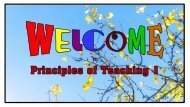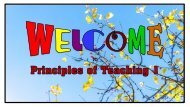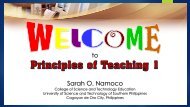Instructional Design Theories and Planning.
You also want an ePaper? Increase the reach of your titles
YUMPU automatically turns print PDFs into web optimized ePapers that Google loves.
This presentation seeks<br />
to find anomalies in the<br />
course syllabus of<br />
Principles of Teaching II<br />
<strong>and</strong> recommends<br />
suggestions how to fix<br />
the identified<br />
anomalies.
This course is aligned with the National Competency- Based<br />
Teacher St<strong>and</strong>ards ( NCBTS), the st<strong>and</strong>ards of good<br />
teaching in the Philippines.<br />
The course is dotted with activities <strong>and</strong> exercises which are<br />
in the crafting of the K to 12 Curriculum.<br />
The learning activities of this course are aligned to<br />
current trends in education such as constructivist,<br />
integrative, interactive, collaborative,<br />
inquiry- based, brain-based,<br />
research-based <strong>and</strong><br />
reflective teaching.
1. Distinguish among approach, method <strong>and</strong> techniques.<br />
2. Compare direct <strong>and</strong> indirect instruction with deductive <strong>and</strong> inductive methods of learning.<br />
3. Show how constructivist teaching is done by the use of interactive, collaborative,<br />
integrative <strong>and</strong> inquiry- based activities.<br />
4. Describe how probe-based learning <strong>and</strong> project-based learning are used as<br />
teaching-learning method.<br />
5. Identify competencies/ content <strong>and</strong> performance st<strong>and</strong>ards in the K- 12 Curriculum<br />
that can be attained by the use of selected relevant instructional strategies.<br />
6. Apply basic guidelines in developing a lesson plan.<br />
7. Explain the frameworks, goals <strong>and</strong> guiding principles<br />
in the teaching of the following;<br />
a. Language subjects (MTB MLE, Filipino <strong>and</strong> English)<br />
b. Social Studies e. Sciences<br />
c. Values Education f. Music, Arts, PE <strong>and</strong> Health<br />
d. Mathematics g. Technology & Livelihood Education
1. Topic/s per class is/are too broad.<br />
2. Statement of learning objectives is not clear as to what the students<br />
should be able to do after the lesson/topic/course is covered.<br />
3. Statement of learning objectives are mostly in lower thinking skills.<br />
4. Too many activities for a given three-hour class<br />
5. The method of assessment: does it meet the learning objectives?
<strong>Design</strong> instructional material<br />
Benefits:<br />
1. The students can view online anywhere at anytime<br />
2. Classroom activities will be focused on constructivist activities such<br />
as the ones identified in the general objectives of the course.<br />
3. The lecturer will be more of a guide on the side rather<br />
than a sage on the stage.
1. Theory of Behaviorism<br />
• Identifying the expected learning behavior in the learning<br />
objectives<br />
2. Theory of Cognitivism<br />
• The short-term memory (STM) capacity can be increased if<br />
material is chunked into meaningful parts.<br />
• STM plays a vital role for learning to take place to LTM<br />
These two theories support the practice of analyzing a task <strong>and</strong><br />
breaking it down into manageable chunks, establishing objectives, <strong>and</strong><br />
measuring performance based on those objectives.
3. Theory of Constructivism<br />
• Knowledge is constructed from experience<br />
• Learning is a personal experience<br />
• Learning is an active process in which the meaning is developed<br />
on the basis of experience<br />
It is from these premises that the instructional designed is patterned<br />
after the Nine Events of Instruction by Robert Gagne.
4. Multiple Intelligences Theory<br />
• Developed by Howard Gardner, 1983<br />
• People have different ways of processing information<br />
5. Cognitive Theory of Multimedia Learning<br />
• Developed by Richard Mayer, 2003<br />
• This theory is based on three main assumptions:<br />
• There are two separate channels (auditory <strong>and</strong> visual)<br />
for processing information<br />
• There is limited channel capacity<br />
• Learning is an active process of filtering, selecting, organizing,<br />
<strong>and</strong> integrating information.
http://citt.ufl.edu/tools/gagnes-9-events-of-instruction/
References<br />
Cognitive Theory of Multimedia Learning (n.d.). Retrieved from Learning <strong>Theories</strong>: https://www.learningtheories.com/cognitive-theory-of-multimedia-learning-mayer.html<br />
Gile, L. (2015, August 13). K to 12 pedagogical approaches. Philippines. Retrieved November 26, 2017, from<br />
https://www.slideshare.net/lyngile/k-to-12-pedagogical-approaches<br />
Gill, E. (2013, January 5). What is Your Teaching Style? 5 Effective Teaching Methods for Your Classroom. Retrieved<br />
November 26, 2017, from https://education.cu-portl<strong>and</strong>.edu/blog/classroom-resources/5-types-of-classroom-teachingstyles/<br />
Kowald, T. O. (2017, February 3). Influential Learning <strong>Theories</strong>: Multiple Intelligences <strong>and</strong> Learning. Retrieved November<br />
25, 2017, from Influential Learning <strong>Theories</strong>: Multiple Intelligences <strong>and</strong> Learning<br />
Mergel, B. (1998). <strong>Instructional</strong> <strong>Design</strong> <strong>and</strong> Learning Theory. University of Saskatchewan, Educational Communications<br />
Technology. Retrieved November 15, 2017, from http://etad.usask.ca/802papers/mergel/brenda.htm<br />
Naqvi, Z. (2016, February 28). Difference between strategy, technique, method. Retrieved November 26, 2017, from<br />
Difference between strategy, technique, method<br />
REVISED Bloom’s Taxonomy Action Verbs. (n.d.). Retrieved November 25, 2017, from<br />
https://www.apu.edu/live_data/files/333/blooms_taxonomy_action_verbs.pdf
PLG 621 – <strong>Instructional</strong> <strong>Design</strong> <strong>Theories</strong> <strong>and</strong> <strong>Planning</strong><br />
Doctor of Education<br />
in Educational Technology <strong>and</strong> Multimedia<br />
School of Educational Studies<br />
Universiti Sains Malaysia<br />
Submitted to<br />
Dr. Amelia Abdullah<br />
Prepared <strong>and</strong> submitted by:<br />
Sarah I. Obsequio-Namoco<br />
Heba Abdulkareem Abulailah<br />
December 2017






